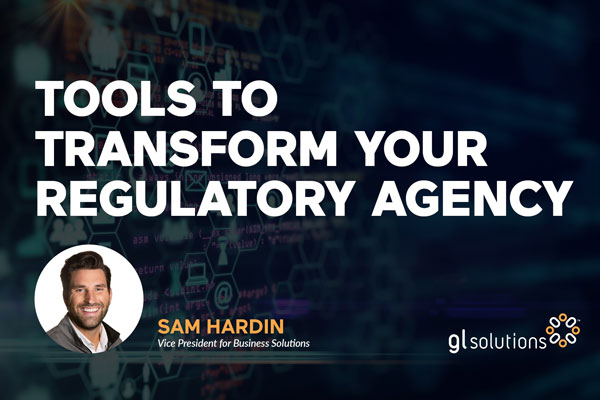Modernizing your state government agency means a host of big changes—for both internal and external stakeholders. And with those changes come complex challenges. Learn the change management tools to use today to start your regulatory agency’s modernization initiative. Vice President for Business Solutions Sam Hardin breaks down those changes into steps.
Hardin presented these steps at the annual 2024 NARA – NWRA Licensing Seminar and Leadership Symposium during his speech, Agency Transformation – Five Steps to Becoming a Model Agency. We summarize the key takeaways from his presentation.
Manage Change
Hardin acknowledges the challenge of modernization efforts and suggests breaking down change into steps. He outlines the five phases of change:
Phases of change:
- Capacity Building—Lay down the foundation for change, both IT-related and not IT-related.
- Process Standardization—Examine what happens at your organization to support large changes.
- Customer Service—Look at who you serve and review how the agency modernization affects that population.
- Integrated Services—Combine process standardization with customer service and focus on how to streamline your efforts.
- Continuous Improvement—Stay in a state of continuous improvement, getting better and working to the next goal.
Build Capacity
When you build capacity in the first phase of agency modernization, Capacity Building, you build a foundation for change. While agency leaders like to skip the capacity building step, says Hardin, he acknowledges the importance of the step.
Most importantly, your regulatory agency defines the mission and vision of your agency. Staff need to understand an end goal—something they strive for. When considering big organizational changes, Hardin suggests “throwing those changes against your mission and vision statements.” Ask whether to make that change in light of your mission and vision. The “stress test” helps clarify whether your agency moves forward—or not—with these changes.
Mission—Your agency defines “what you do and how you do it,” says Hardin. He stresses the importance of communicating that to your internal stakeholders to permeate the organization.
Vision—You look to the future about what you plan to achieve. You focus on communicating a “big bold statement” to your external stakeholders.
Stakeholder analysis—Understand decision makers, subject matter experts and other stakeholders to help you with decision making through the change.
Tip: Stakeholder Analysis tool
Use the following easy stakeholder analysis tool to “delineate who does what in the project and who is involved,” explains Hardin.
- List out participants involved in the change, for example your staff, your customers and the legislature.
- Write out the objective for each participant related to the change.
- Then rate that participant’s influence.
- Add potential risks for each participant.
Distribute the information to those involved with the project to give them direction on who to turn to during the project for input and support.
Culture mapping—Memorialize how your regulatory agency handles change. Identify the behaviors around change to identify what your staff must address as change occurs.
Overall project goal—Set high-level objectives for the change, such as saving money or improving service, for example. Start thinking about how you plan to measure those goals.
Understand the process of change, enduring the hardship of change; “celebrate those short-term wins” along the way, says Hardin.
Standardize Processes
In phase 2, Process Standardization, you focus on internal stakeholders to support the change. “Real change occurs here,” says Hardin.
Process maps/flows—Identify your process flows and how everyone performs that work. Hardin says you “roll up your sleeves and get into the nitty gritty of change” when you recognize your current business processes.
Guiding principles—Hardin calls this one of the “biggest topics” under process standardization, explaining that we all must follow a set of laws and regulations. You must ensure that the process maps and flows at your regulatory agency follow the regulations of your state. If your rules spell out applying a late fee, for example, then your licensing processes must reflect that. Along with this, ensure that your processes reflect the values of your regulatory agency.
SME’s—Identify your subject matter experts (SMEs) for each process and share their knowledge with all. Make that information part of the process.
Communication & consistency—Decide when and how to communicate information about the project. Choose who to involve. Select the tools to support sharing, like Teams or Slack, for example.
Transformation/change/plan—Take all of the preceding items in phase 2, from business process maps to SME’s and add them to a digital transformation plan as an important reference guide.
Goals and scope—Outline the parameters of the plan; decide the scope and boundaries of the modernization project. Review with stakeholders and decide if the goals and scope plan make sense to all involved.
Serve Customers
In phase 3, Customer Service, you focus on the external stakeholders.
Storyline—Understand the “storyline” for those customers; map out the timeline for a customer from A to Z to better realize what you need to support them with.
Customer persona—Sketch out what the average customer looks like; for example, describe their educational level. Assess their average website use ability. Ask yourself, says Hardin, “how foolproof does our process need to be?”
Process accessibility and efficiency—Ask how you need to support the access for customers with the change? Understand the end-user. Put on your “customer hat” and decide on how you hope the process to go.
Integrate Service
In phase 4, Integrated Service, you decide how to integrate phase 2, an internal focus with phase 3, an external focus. Your regulatory agency creates an “information highway,” blending the internal processes with the external focus. For example, you create a process. Your customers input information. You put workflow on top of that, Hardin explains, and then need to make that information accessible, streamlined and easy to use.
Automation—Focus on making the information readily available with automation. For example, communicate with your licensees via text message.
Transformational—As you modernize and make changes to your process, next ask how your regulatory agency must adapt; this requires some “major changes” in some cases, Hardin explains. For example, if you add an AI chatbot to answer questions, that really changes the way your staff work, likely meaning less time on the phone. Also consider how to prepare the end user.
Tip: Spider Mapping
Pair your internal processes with your external solutions. List out your internal processes and then write out your external solutions. For example, if you describe applications as an internal process, possible external solutions to list include website and auto alerts.
Improve Continuously
In phase 5, your regulatory agency commits to continuous improvement on your modernization journey.
Data analytics—Your regulatory agency must consistently review the data to gauge your progress towards meeting your objectives.
Re-analyze mission and vision—As you complete your major changes and transition to improving continuously, review your mission and vision again; decide if either of those need updating.
Reevaluate goals—After you meet your goals, come up with new modernization project goals to work towards. “This keeps us moving forward,” says Hardin.
Celebrate the wins—Acknowledge that you met your goals. Celebrate those accomplishments! Try to look backwards and acknowledge what you achieved and what you learned, says Hardin.
Evaluation—Review the standards you set for your team and your organization with continuous monitoring. Evaluate how you perform after the changes. Reverting to past ways costs your regulatory agency a lot in terms of money, time and energy, says Hardin. So, keep tabs on your organization’s performance post-change.
Agency Transformation – Five Steps to Becoming a Model Agency
Sam Hardin presented the information in this article at the annual 2024 NARA – NWRA Licensing Seminar and Leadership Symposium during his speech, Agency Transformation – Five Steps to Becoming a Model Agency.
- Learn more about the National Association for Regulatory Administration (NARA). NARA describes their mission as to “promote the health and safety of children and adults in regulated settings.”
- Learn more about the National Workforce Registry Alliance (NWRA). NWRA describes their organization as: a “non-profit membership organization composed of state early childhood professional development registries and early learning workforce allies. We work to strengthen state registries, standardize the equitable collection and analysis of workforce data, and cultivate space for collaboration.”
- And learn more about GL Solutions’ Agency Transformation Service, our phased approach to modernize your regulatory agency.
Time to Modernize
GL Solutions helps your regulatory agency run, grow and adapt through modern software and automation that helps solve your agency’s greatest challenges. To learn more, contact us.
To receive the latest regulatory news delivered to your inbox each week, subscribe to our newsletter.


